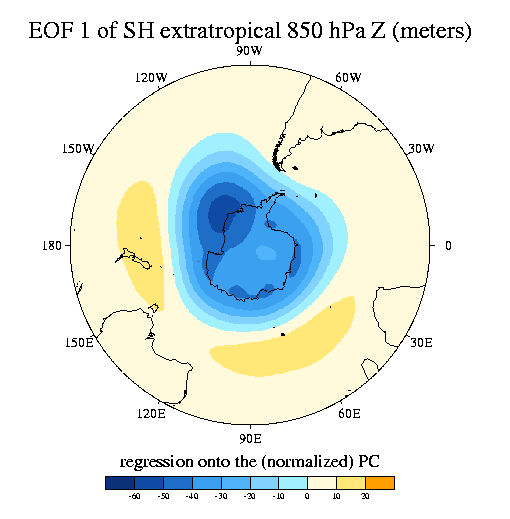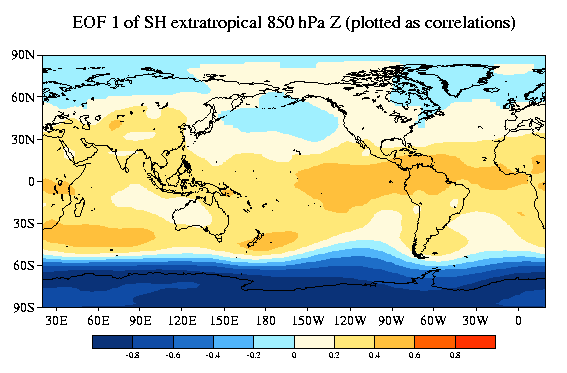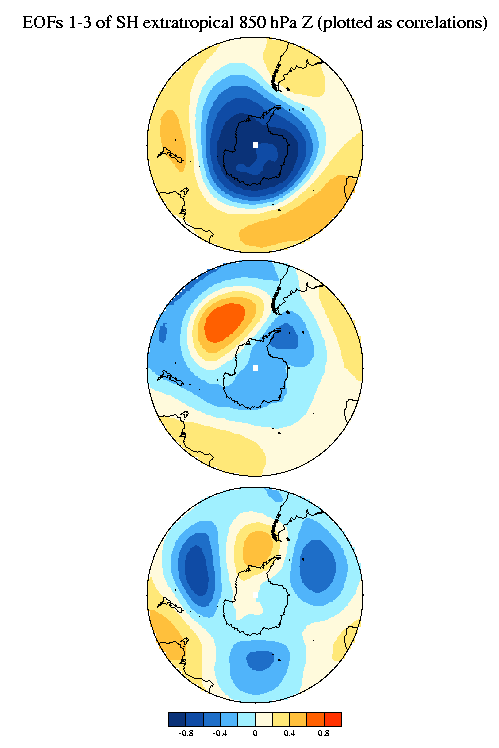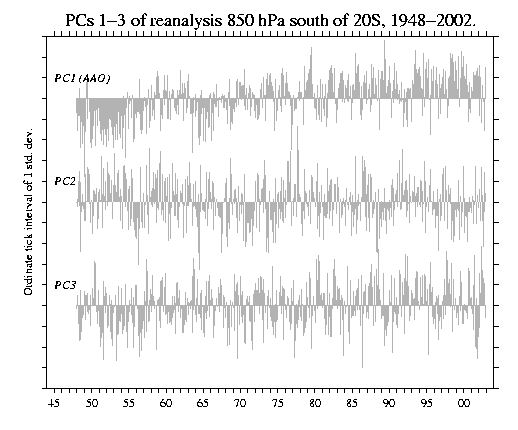
PostScript | JPEG | PNG
Definition and analyses | Data
The Antarctic Oscillation (AAO) is the dominant pattern of non-seasonal tropospheric circulation variations south of 20S, and it is characterized by pressure anomalies of one sign centered in the Antarctic and anomalies of the opposite sign centered about 40-50S. The AAO is also referred to as the Southern Annular Mode (SAM). There is a Northern Hemisphere analog to the AAO, and it is called the Arctic Oscillation (or Northern Annular Mode). More information is available on annular modes through this link.
The AAO is defined as the leading principal component (PC) of 850 hPa geopotential height anomalies south of 20S (Thompson and Wallace 2000). (An AAO index calculated from SLP anomalies is available through this link.) I have calculated the PC (time series) of this pattern from the NCEP / NCAR reanalysis, and all calendar months are used. There are concerns about the usefulness of the reanalysis in the Antarctic (see articles in J. Climate). The AAO time series for 1968-98 can be compared with the index calculated by Thompson and Solomon (2002) from 500 hPa geopotential height from radiosondes.



The AAO is calculated with PC analysis, and this analysis yields a large set of modes, of which the first 3 explain 33, 11, and 9% of the variance, respectively. The spatial patterns and time series of each of these modes are shown in the next figure. The spatial maps are plotted as correlation maps, with the value at each grid point given as the correlation coefficient of the time series at that grid point with the PC for that mode.


References:
Data: All of the time series are standardized with respect to 1948-2002.
jan feb mar apr may jun jul aug sep oct nov dec
1948 -70 -155 -157 -81 47 -84 -231 -237 -110 -198 -216 -130
1949 -271 -378 -163 2 79 79 -97 0 -63 -41 -75 -212
1950 -236 -162 -193 -129 -48 -58 -229 -165 -53 -60 -132 -31
1951 -43 -108 -104 -169 -203 -153 -124 -171 -223 -148 -105 -176
1952 -232 -106 -148 -204 -137 -99 -87 -103 -137 -84 -174 -236
1953 -207 -139 -116 -197 -121 -97 -200 -42 -62 -172 -91 -187
1954 -34 -84 -242 -140 10 -79 -81 -286 -20 -46 28 -145
1955 -67 -25 11 -12 -71 -94 14 -207 -98 -193 -155 -76
1956 -91 -85 -63 -63 -42 92 -75 -152 -171 -94 -66 -149
1957 -58 -12 4 -42 -60 -172 -22 -32 43 -139 -108 -107
1958 64 -4 -24 -84 -53 32 -102 15 102 26 66 133
1959 109 6 25 -94 -156 -76 -84 -97 38 -30 112 27
1960 40 35 113 -98 -98 35 -8 -104 -52 22 45 25
1961 42 -44 -14 -15 -62 -74 -28 40 -77 16 42 134
1962 114 21 14 73 26 -109 71 3 48 -67 -44 85
1963 119 80 12 -76 -35 -76 -78 -263 -70 6 -4 22
1964 -89 -59 -10 -14 -13 -190 -225 -182 17 38 -75 -46
1965 -15 -204 -45 -88 -208 -23 -96 -62 -78 -142 17 -139
1966 26 -54 -202 -70 -156 32 -24 22 -41 71 -42 -11
1967 -88 -39 6 -6 -6 -19 13 23 -43 9 -44 13
1968 -14 -53 -24 -16 -121 32 94 -33 -151 -114 -98 -7
1969 -122 -51 -1 -66 -22 -39 85 92 41 -30 78 24
1970 79 58 -5 8 62 63 -33 143 16 -55 50 -56
1971 -37 27 63 3 -86 50 -41 28 32 21 18 -57
1972 -95 -25 -30 -104 -13 -100 -53 -79 4 46 74 -37
1973 -43 42 103 15 -106 15 93 124 16 63 0 112
1974 -2 120 78 42 58 -14 34 -154 91 5 -105 -85
1975 -58 24 38 63 -37 5 -63 121 144 113 24 12
1976 -32 73 37 126 72 33 15 30 16 -34 -135 -245
1977 -128 7 17 -57 -56 -48 -20 -50 6 28 22 -13
1978 85 28 -2 28 -1 6 -129 157 109 41 6 77
1979 90 79 120 130 143 208 250 47 68 45 6 -43
1980 24 -51 -72 -100 42 65 -77 4 -102 92 -113 3
1981 67 61 -51 -82 10 70 -34 -138 -93 24 89 138
1982 24 80 144 158 79 122 32 101 144 -27 -5 -117
1983 -54 -24 51 73 43 36 120 121 -16 129 74 86
1984 -21 3 65 51 -12 87 115 -17 11 44 57 -103
1985 -20 63 39 66 38 18 219 122 155 78 166 154
1986 77 -81 -27 60 -102 -55 76 22 110 75 54 130
1987 -25 -7 27 43 67 7 -62 165 -29 95 149 73
1988 21 95 27 65 26 -13 135 12 -16 -152 92 131
1989 93 132 87 21 279 228 188 23 7 60 89 18
1990 39 158 72 -95 -91 37 -20 89 172 63 43 36
1991 132 -4 66 20 37 -25 -12 78 -16 -4 -2 -136
1992 44 -67 -18 29 -101 -137 50 48 43 1 46 49
1993 -110 90 12 69 160 165 234 171 143 123 94 141
1994 121 151 108 80 51 -84 46 218 -38 5 -1 141
1995 176 98 37 93 188 -8 -174 17 142 17 82 158
1996 62 -2 84 87 151 35 68 -39 -98 117 -76 48
1997 67 21 101 10 142 21 129 109 44 0 -93 -36
1998 96 107 106 220 98 193 215 174 38 83 143 182
1999 134 88 46 146 205 -39 100 91 52 226 152 203
2000 160 106 46 91 165 84 62 30 -114 78 -51 -70
2001 53 6 35 129 53 112 15 111 133 128 121 145
2002 107 162 -85 104 -116 1 37 62 -15 -158 -26 151